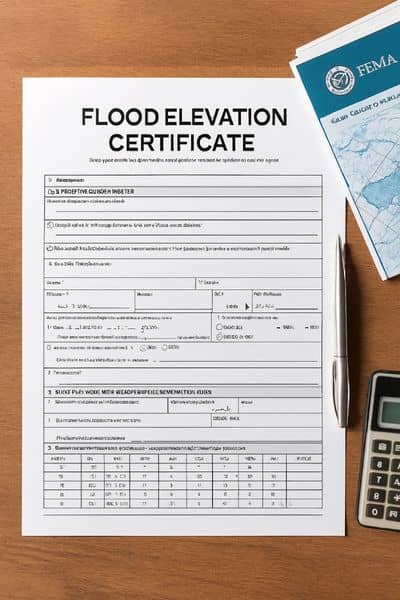
If you are buying or selling a home, you’ve likely heard the news: the National Flood Insurance Program (NFIP) lapsed on October 1, 2025, after Congress missed its funding deadline. In just a week, the impact is already being felt across the real estate market. Closings in flood-prone neighborhoods are facing delays, and deals that seemed solid days ago are now at risk. The tool that can keep things moving is a flood elevation certificate, a document that helps buyers, sellers, and lenders avoid getting stuck during uncertain times.
What the NFIP Lapse Really Means
The NFIP provides most of the flood insurance policies across the United States. When it’s active, homeowners in flood zones can secure affordable coverage, and lenders can confidently approve mortgages. But during a lapse, the program cannot issue new policies. That means if you’re under contract for a home in a flood zone, your closing may hit a roadblock.
Renewals for existing NFIP policies may continue, but adjustments, endorsements, or new coverage are frozen until Congress takes action. In Indianapolis, this can affect properties near the White River, Fall Creek, Eagle Creek, and Pleasant Run. Lenders need proof of flood insurance, and without it, they simply will not fund the loan. That is why so many real estate agents and buyers are scrambling right now.
Why a Flood Elevation Certificate Matters

A flood elevation certificate is a document prepared by a licensed land surveyor. It shows the exact elevation of a building compared to FEMA’s base flood elevation. In simple terms, it answers the question: is the home sitting above or below the level where serious flooding is expected?
For lenders, this certificate provides the confidence they need to move forward when NFIP is offline. It helps underwriters determine if private flood insurance is a workable option. For buyers, it can reveal whether flood risk is as severe as it looks on FEMA’s maps. Sometimes the maps show a property inside a flood zone when the house itself is actually above the danger line. With the right certificate in hand, a loan that looked impossible may suddenly be able to close.
The Local Impact in Indianapolis
Indianapolis has several neighborhoods that run along rivers, streams, and low-lying areas. Homes near Broad Ripple, Rocky Ripple, and downtown stretches of the White River are most exposed. Properties around Eagle Creek Reservoir also face higher risk, and parts of the Fall Creek and Pleasant Run corridors have similar challenges.
When the NFIP pauses, these communities feel the effect first. A buyer may fall in love with a home, line up financing, and then discover that the mortgage cannot close until flood coverage is secured. Without a flood elevation certificate, the process may take weeks—or worse, fall through completely.
How Surveyors Help Keep Closings on Track
When a deal is in danger because of an NFIP lapse, the first call many lenders and real estate agents make is to certified surveyors for flood and property needs. These professionals can prepare a flood elevation certificate quickly, giving buyers and lenders the data they need to keep a closing alive. By measuring the lowest floor elevation, comparing it to FEMA’s base flood level, and certifying the results, the surveyor provides hard evidence.
With that evidence, lenders may turn to private flood insurance providers while NFIP is offline. In some cases, the certificate even shows that the home qualifies for a Letter of Map Amendment (LOMA), which officially removes the property from the flood zone. That can save thousands of dollars in long-term insurance costs.
In a city like Indianapolis, where buyers want to move fast and sellers need deals to close on time, having the right surveyor involved makes all the difference. That’s why they become essential partners during NFIP lapses.
What Buyers and Sellers Should Do Right Now
If you’re buying a home in a flood-prone area, ask early about a flood elevation certificate. Don’t wait for your lender to raise the issue. Having one ready gives you more options if NFIP delays drag on. Sellers can also stay ahead by ordering a certificate before listing. This not only reduces surprises but also makes the property more attractive to cautious buyers.
Real estate agents should make this part of their due diligence process. A simple question to the seller—“Do you have a current flood elevation certificate?”—can save weeks of stress down the line. And for lenders, keeping a list of surveyors who can deliver certificates quickly is just smart business.
Workarounds During the Lapse
While NFIP is paused, private flood insurance becomes a lifeline. These policies often require more documentation, but a flood elevation certificate is the key that makes them possible. Buyers who already have binders issued before the lapse may still close, but timing is critical. If you’re under contract, check with your lender immediately to see if the certificate can be used to satisfy underwriting.
The NFIP lapse may last days or weeks, but real estate deals can’t always wait. That’s why having the right paperwork in hand today is so important.
Protecting Closings in Flood-Prone Indy
The NFIP shutdown is a reminder that real estate is about more than just location and price. In Indianapolis, where rivers and creeks shape so many neighborhoods, flood risk is part of the equation. A flood elevation certificate turns that risk into clear numbers that buyers, sellers, and lenders can act on.
So if you’re planning to close on a home near the White River, Fall Creek, or Eagle Creek, don’t let a government delay derail your plans. Order a certificate, stay ahead of the process, and keep your closing on track.
Closing Thought
Real estate deals are stressful enough without the added pressure of federal shutdowns. But in every challenge, there’s a solution. In this case, the flood elevation certificate is the bridge that helps buyers and sellers keep moving forward. Don’t wait until the deal is on the line—take action now and protect your closing from the ripple effects of an NFIP lapse.





